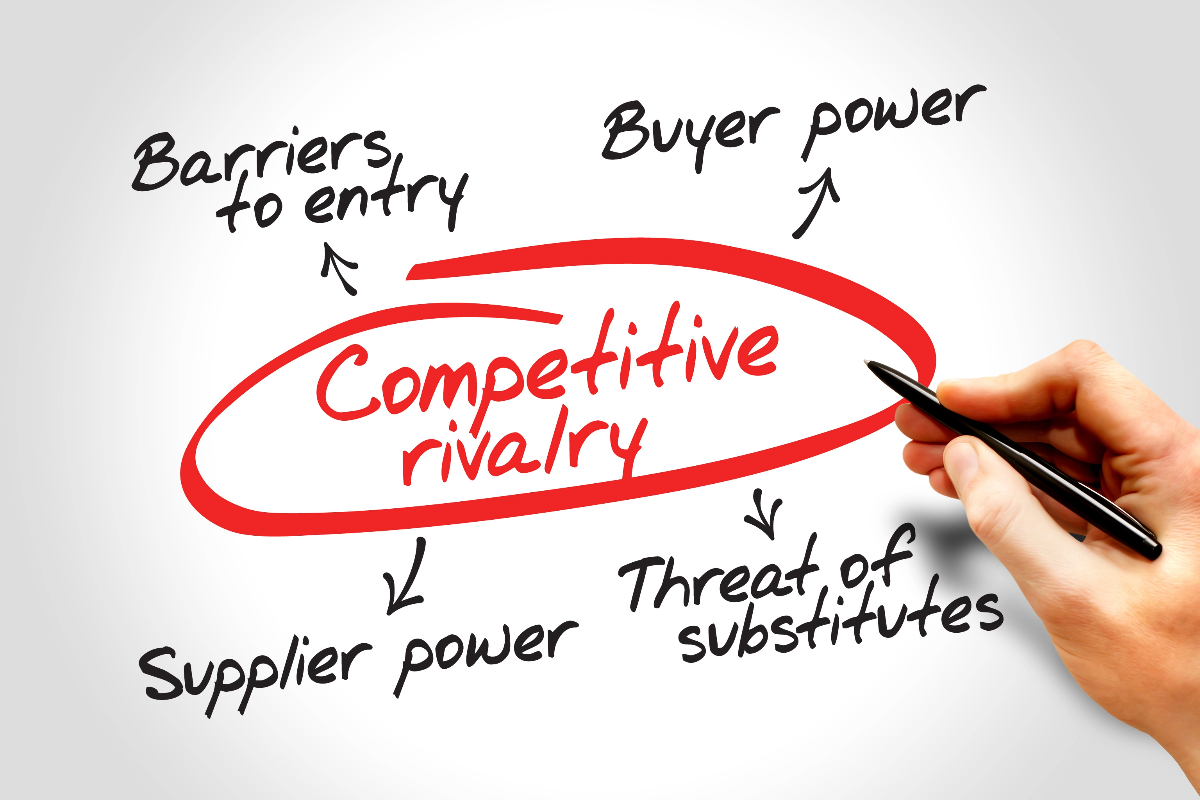Unlocking Porter’s Five Forces Model: A Comprehensive Guide
Understanding the competitive forces that shape industries is vital for success in the ever-changing business landscape. Enter Porter’s Five Forces Model, a comprehensive framework that dissects the dynamics of industry competition and profitability. This blog post will delve into the model’s origin, relevance, and application in real-world scenarios and its limitations and strategies for leveraging its insights. Get ready to unlock the secrets of Porter’s Five Forces and empower your business decision-making!
Key Takeaways
- Porter’s Five Forces Model is a tool used to analyze the attractiveness of an industry and its competitive forces.
- It enables businesses to gain insights into their industry’s competition, develop strategies for gaining a competitive advantage, and create successful initiatives for long-term profitability.
- Companies should focus on one strategy, such as cost leadership or differentiation, to avoid being “stuck in the middle” and maintain their competitive edge.
Understanding Porter’s Five Forces Model

Harvard Business School professor Michael E. Porter introduced a powerful tool for analyzing industry structure and competition in 1979 – the Five Forces Model. It evaluates the attractiveness of an industry by examining the five competitive forces that shape it:
- The threat of new entrants
- Bargaining power of suppliers
- Bargaining power of buyers
- Threat of substitute products or services
- Competitive rivalry
As the business environment evolves, the model remains relevant, helping companies navigate the challenges posed by globalization, technological advancements, and shifting customer preferences.
Origin of the Model
Michael E. Porter first introduced the Five Forces Model in his book, “Competitive Strategy: Techniques for Analyzing Industries and Competitors,” published in 1979. In his Harvard Business Review article, Porter encouraged business leaders to analyze the forces in their broader environment that shape industry competition.
Comprehending these forces enables organizations to position themselves within their industries and make well-informed decisions strategically
Relevance in Today’s Business Environment
Despite age, the Five Forces Model is useful for analyzing a company’s competitive position and understanding how competition influences strategy. While some critics argue that the model may not be as applicable to companies operating within the digital economy, it still offers valuable insights into traditional industries with high entry barriers, intense competition, and price-sensitive customers.
Nonetheless, it’s important to acknowledge the model’s application may vary across different industries in today’s business environment. For example, the threat of substitution and the market state can be difficult to assess in rapidly changing industries such as technology.
Nevertheless, Porter’s Five Forces Model provides a solid foundation for analyzing industry competition and profitability, enabling businesses to adapt and succeed in the modern world.
Unlock the Full Potential of Porter’s Five Forces Model with Expert Guidance
The realm of business is vast, intricate, and ever-evolving. While Porter’s Five Forces Model offers a comprehensive framework to understand competitive forces within your industry, the true depth of its potential is unlocked when paired with expert guidance. Every industry, every business, is unique. Applying any strategic model, including Porter’s, demands a tailored touch to resonate with your business’s specific challenges and opportunities.
As an executive or key personnel, you’re the backbone of your enterprise. With the high stakes, doesn’t it make sense to bolster your strategic decisions with seasoned insight?
Reach out to a Vancouver-based Executive and Business Coach today. Together, we can traverse the nuances of your industry, positioning your business not just to navigate but to thrive. Let’s turn insights into actions, theories into tangible results, and your aspirations into achievements.
Consider all perspectives. Unlock unseen potential. And let’s elevate your business strategy to unparalleled heights. 🚀
Contact a Business Coach Today! Click here!
Breaking Down the Five Competitive Forces

An in-depth examination of the Five Forces Model unveils the intricacies of each force and their cumulative effect on industry competition and profitability. By exploring the following forces, businesses can better understand their industry’s structure and formulate strategies to secure a competitive advantage:
- The threat of new entrants
- Bargaining power of suppliers
- Bargaining power of buyers
- Threat of substitute products or services
- Competitive rivalry
Understanding the Five Forces Model gives businesses insights into their industry’s competition.
The threat of New Entrants
The threat of new entrants evaluates the potential for new competitors to enter an industry and the obstacles that may hinder their entry. High entry barriers protect existing firms, reducing the risk of new entrants and ensuring the industry’s profit potential remains intact. On the other hand, low entry barriers invite a constant influx of new competitors, intensifying competition and putting pressure on established companies to defend their market share.
Illustrating this concept, Apple’s entrance into the music distribution industry with the iPod presented a significant threat to existing players. The low barriers to entry meant that new competitors could easily enter the market, capturing market share and undermining the profitability of established companies.
Therefore, grasping the threat of new entrants and understanding existing competitors is vital for businesses crafting strategies that preserve their competitive edge and profitability.
Bargaining Power of Suppliers
Supplier power, also known as suppliers’ bargaining power, is the influence suppliers have on industry profitability and the factors that shape their bargaining power. A limited number of suppliers or the presence of sole providers can increase supplier power, enabling them to increase prices and negotiate favourable terms. Conversely, many suppliers or low switching costs between rival suppliers can reduce input costs and enhance a company’s profit margins.
For instance, in the consumer electronics industry, the scarcity of rare earth minerals grants suppliers moderate bargaining power over companies like Apple. The limited number of sources for these materials enables suppliers to set higher prices, which can negatively impact the profitability of electronic manufacturers.
Appreciating supplier power is crucial for businesses to effectively manage their supply chain and uphold a competitive position in the market.
Bargaining Power of Buyers

The bargaining power of buyers represents the influence customers have on an industry, considering the factors that contribute to their bargaining power. The presence of few buyers and many sellers, large buyer orders, and high switching costs can increase buyer power, enabling them to demand lower prices or higher quality products and services. This can lead to increased competition among firms and reduced profitability.
For example, in the food retail sector, strong buyer power exists due to the large number of retail options and the ease with which customers can switch between retailers. This intense competition forces retailers to offer competitive prices or risk losing market share. Therefore, recognizing the bargaining power of buyers is critical for businesses to devise strategies that meet customer preferences and sustain profitability.
Threat of Substitute Products or Services
The threat of substitute products or services evaluates the risk posed by alternative solutions that can replace existing offerings in an industry. The availability of substitutes can significantly impact the demand for a company’s products or services, forcing them to differentiate themselves or lower prices to remain competitive. As substitutes become more attractive to customers, the industry’s profit potential can be constrained.
In the transportation industry, for example, substitute products such as ride-sharing services like Uber and Lyft emerged shortly after smartphones became widespread. These substitutes presented a significant challenge to traditional taxi companies, forcing them to adapt their business models or risk losing market share to these new entrants.
Recognizing the threat of substitutes enables businesses to innovate and distinguish themselves, securing long-term survival amidst competition.
Competitive Rivalry
Competitive rivalry assesses the intensity of competition among existing firms and the factors driving this rivalry. A high level of rivalry can result from numerous factors, such as the number of competitors, low product differentiation, or slow industry growth. As competitive intensity increases, businesses may struggle to maintain their market share and profitability.
Competitive rivalry takes center stage in Porter’s Five Forces Model as the dominant factor determining an industry’s attractiveness. Discerning the intensity and direction of competitive forces allows businesses to evaluate their competitive standing and formulate fitting strategies swiftly. Competitive forces shape strategy in various industries, as seen in companies like McDonald’s, which have successfully implemented cost leadership strategies to maintain their competitive advantage in the face of fierce rivalry in the fast-food industry.
Real-World Applications of Porter’s Five Forces Analysis

Porter’s Five Forces Analysis has proven its value in numerous industries, offering insights for businesses to navigate the complexities of their competitive environment. The model provides a comprehensive understanding of industry competition and profitability in various sectors, including:
- Higher education
- Airline industry
- Music Business
- Retail giants like Walmart
- Disruptive transportation services like Uber
Let’s examine how the model has been applied in various sectors.
Higher Education Sector
Porter’s Five Forces Analysis can be applied to the higher education sector to examine the competitive environment. The bargaining power of buyers, threats of substitutes, and competitive rivalry are crucial forces to consider in this industry. Students are increasingly viewed as a consumer product, seeking alternatives offering more attractive features or lower costs than traditional institutions.
To remain competitive, universities must differentiate by offering unique value propositions that appeal to their target audience. This can include offering specialized programs, providing flexible learning options, or building strong partnerships with industry partners.
Recognizing the forces influencing the higher education sector enables institutions to devise strategies for attracting and retaining students, ensuring their ongoing success in a progressively competitive market.
Airline Industry
Porter’s Five Forces Analysis can be employed to examine the competitive landscape of the airline industry. Factors such as:
- Supplier power
- Buyer power
- Entry and exit barriers
- Threat of substitutes
- Competitive rivalry
All influence the industry’s structure and attractiveness. The airline industry faces high fixed costs and intense competition, making it crucial for businesses to differentiate themselves and maintain cost efficiencies.
Low-cost airlines such as RyanAir have successfully implemented cost leadership strategies to maintain profitability in the face of intense competition. Meanwhile, other airlines focus on differentiation through superior customer service, in-flight amenities, or loyalty programs.
Applying Porter’s Five Forces Analysis to the airline industry equips businesses to spot opportunities and threats, facilitating strategic decision-making.
Music Industry
The music industry is another sector where Porter’s Five Forces Analysis can provide valuable insights. The bargaining power of customers, the competitive environment, and the threat of substitutes all play a significant role in shaping the industry’s landscape. With the proliferation of streaming services and the impact of piracy on the industry, understanding these forces is crucial for businesses to maintain their competitive edge.
Artists and record labels must adapt to the changing landscape by offering unique content and leveraging digital platforms to reach their audience. Additionally, streaming services can differentiate themselves through personalized recommendations, exclusive content, or strategic partnerships.
Applying Porter’s Five Forces Analysis to the music industry empowers businesses to comprehend the competitive dynamics and devise strategies to guarantee success in a swiftly changing market.
Retail Industry: Walmart
Porter’s Five Forces Analysis can be applied to evaluate the retail industry, with Walmart as a prime case study. The company faces intense competition and potential entry of new players in the market. However, Walmart’s focus on cost leadership has allowed it to maintain a competitive advantage and offer lower prices than competitors, attracting price-sensitive customers.
Additionally, Walmart’s extensive supply chain and strategic partnerships with suppliers have enabled the company to maintain its competitive edge in the market. Utilizing Porter’s Five Forces Analysis facilitates Walmart in continuously evaluating the competitive landscape and making strategic decisions to maintain its position in the retail industry.
Transportation Industry: Uber
Applying Porter’s Five Forces Analysis to the transportation industry, focusing on Uber, reveals the market’s competitive forces. The threat of new entrants is high in the transportation industry due to low barriers to entry. Meanwhile, the bargaining power of suppliers, such as drivers, is moderate due to the availability of alternative platforms for drivers to offer their services.
Moreover, the threat of substitute products or services, such as Lyft and other ride-hailing services, challenges Uber’s market dominance. Using Porter’s Five Forces Analysis helps Uber to comprehend its competitive environment better and formulate strategies to uphold its competitive advantage in the transportation industry.
Limitations of Porter’s Five Forces Model

While Porter’s Five Forces Model offers valuable insights into the competitive forces shaping industries, it is not without its limitations. Critics argue that the model is outdated, lacks versatility, and does not consider modern technology’s influence or globalization’s effects on competition. Furthermore, the model tends to analyze individual companies rather than broad industries, limiting its applicability in some cases.
Despite these criticisms, Porter’s Five Forces Model remains a valuable tool for businesses to assess their competitive landscape and make informed strategic decisions. Acknowledging the model’s constraints and enhancing it with extra analyses like SWOT analysis or forming strategic alliances enables businesses to understand their industry’s attractiveness and profitability.
Strategies for Leveraging Porter’s Five Forces Analysis
Based on the insights gained from Porter’s Five Forces Analysis, businesses can adopt one of three key strategies to secure a competitive advantage: cost leadership, differentiation, or focus. Focusing on one of these strategies enables companies to sustain their profitability as industries mature and competition escalates.
Let’s delve deeper into each of these strategies.
Cost Leadership Strategy
The cost leadership strategy focuses on minimizing costs associated with providing a product or service, allowing businesses to:
- Offer lower prices than their competitors
- Attract price-sensitive customers
- Increase market share
- Remain profitable during price wars.
Successful examples of cost leadership implementation include McDonald’s, Walmart, and RyanAir.
Differentiation Strategy

The differentiation strategy emphasizes offering unique products or services that customers perceive as valuable and distinct from competitors. By creating a differentiated offering, businesses can charge higher prices and reduce the threat of new entrants and substitute products. This strategy can also help diminish the bargaining power of buyers and suppliers, as customers are likely to pay a premium for unique offerings, and suppliers may be more likely to collaborate with a differentiated firm.
Apple and Walmart are companies that have successfully implemented a differentiation strategy.
Focus Strategy
The focus strategy targets a specific market segment, allowing businesses to tailor their offerings to meet the unique needs of that segment. By concentrating on a restricted competitive range, companies can become experts in providing value to their target market, fostering strong customer loyalty within their chosen niche.
This strategy can also help mitigate the impact of other competitive forces, such as the threat of new entrants or the bargaining power of buyers and suppliers. TOMS, Frog Box, and Ten Tree Apparel are businesses that successfully employ a focus strategy.
Avoiding the Trap of Being “Stuck in the Middle”

Focusing on a single strategy, cost leadership, differentiation, or focus is essential to avoid being “stuck in the middle.” When companies attempt to serve multiple strategies simultaneously, they risk losing their market position and profitability as industries mature. By concentrating on one strategy, businesses can maintain their competitive advantage and navigate the challenges of intense competition and market saturation.
Examples of companies that have successfully avoided the “stuck in the middle” trap include McDonald’s, which focused on cost leadership, and Apple, which chose a differentiation strategy. By clearly defining their competitive strategy and executing it effectively, these companies have thrived despite industry competition and maturation challenges.
Utilizing Porter’s Five Forces Templates
Several templates are available to simplify conducting a Porter’s Five Forces Analysis that can help streamline and keep the analysis organized. The Cascade Template, for example, offers a comprehensive and systematized approach to analyzing the competitive environment and formulating successful strategies.
Employing templates, such as the Cascade Template, ensures a thorough and accurate analysis while saving businesses time and effort. Downloadable templates can be found online, making them easily accessible for businesses looking to conduct a Porter’s Five Forces Analysis.
Utilizing these templates helps companies:
- Gain valuable insights into their competitive surroundings
- Make informed strategic decisions
- Uphold their competitive advantage in their respective industries.
Implementing Findings and Initiatives from Porter’s Five Forces Analysis
After conducting a Porter’s Five Forces Analysis, businesses must effectively apply the insights to inform their strategy and decision-making. This involves:
- Recognizing the competitive forces
- Evaluating their impact
- Formulating strategies
- Executing initiatives
- Tracking and adjusting to changes in the industry
Implementing these findings allows companies to fortify their market position and sustain their profitability amidst competition.
To effectively implement Porter’s Five Forces Analysis, businesses must continuously monitor their competitive environment and adapt their strategies accordingly. Staying agile and responsive to market changes enables companies to preserve their competitive advantage and flourish amidst industry competition and maturation.
Summary
In conclusion, Porter’s Five Forces Model remains a valuable tool for businesses to analyze their competitive environment and formulate effective strategies. Although the model has limitations, it provides a solid foundation for understanding industry competition and profitability. Businesses can secure their competitive advantage and thrive in an ever-changing business landscape by leveraging the insights gained from a Porter’s Five Forces Analysis and focusing on cost leadership, differentiation, or focus strategies.
Frequently Asked Questions
What is the main purpose of Porter’s Five Forces Model?
The main purpose of Porter’s Five Forces Model is to analyze the competitive forces within an industry. It helps businesses understand the strength of competition and profitability in their industry, thereby aiding in strategic decision-making.
How can Porter’s Five Forces Model be applied in a real-world scenario?
Porter’s Five Forces Model can be applied in various sectors to analyze the competitive environment. It can be used to assess the strength of competition in industries such as higher education, airline, music, retail, and transportation.
What are the limitations of Porter’s Five Forces Model?
While Porter’s Five Forces Model provides valuable insights, it has limitations. Critics argue that the model may not fully consider modern technology’s influence or globalization’s effects on competition. Also, the model tends to analyze individual companies rather than broad industries, which can sometimes limit its applicability.
What strategies can businesses adopt based on Porter’s Five Forces Analysis?
Based on the insights gained from Porter’s Five Forces Analysis, businesses can adopt one of three key strategies to secure a competitive advantage: cost leadership, differentiation, or focus. These strategies enable companies to sustain their profitability as industries mature and competition escalates.
What are the 5 forces of Porter’s model?
Porter’s Five Forces Model comprises five distinct forces – Competitive Rivalry, Supplier Power, Buyer Power, Threat of Substitution and Threat of New Entry – which are used to assess the level of competitiveness in a given industry. This framework helps strategists understand what makes an industry profitable and provides insights needed to make strategic choices.
Unlock the Full Potential of Porter’s Five Forces Model with Expert Guidance
The realm of business is vast, intricate, and ever-evolving. While Porter’s Five Forces Model offers a comprehensive framework to understand competitive forces within your industry, the true depth of its potential is unlocked when paired with expert guidance. Every industry, every business, is unique. Applying any strategic model, including Porter’s, demands a tailored touch to resonate with your business’s specific challenges and opportunities.
As an executive or key personnel, you’re the backbone of your enterprise. With the high stakes, doesn’t it make sense to bolster your strategic decisions with seasoned insight?
Reach out to a Vancouver-based Executive and Business Coach today. Together, we can traverse the nuances of your industry, positioning your business not just to navigate but to thrive. Let’s turn insights into actions, theories into tangible results, and your aspirations into achievements.
Consider all perspectives. Unlock unseen potential. And let’s elevate your business strategy to unparalleled heights. 🚀



